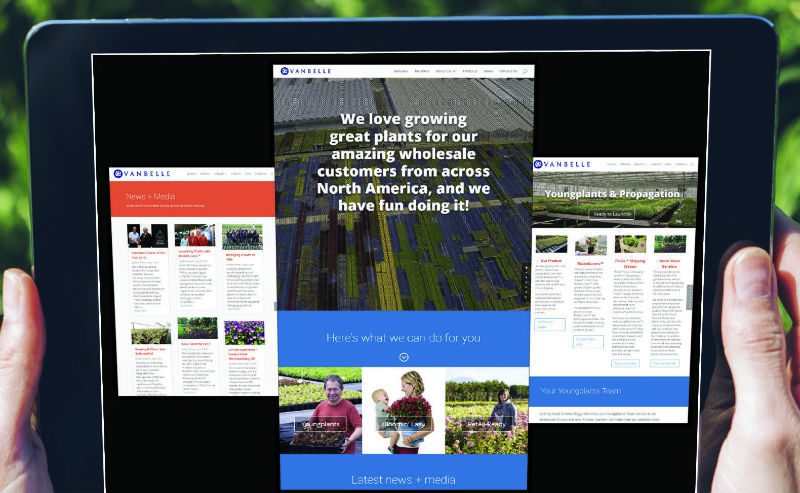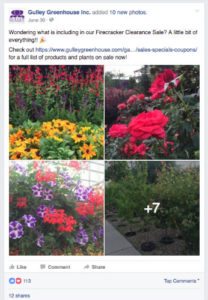
Growing an Online Presence
Your website is often the first place where potential customers are introduced to your company. Making that first impression can be critical — but there’s more to it than just creating a website. When establishing an online presence, you need to have a strategy that involves multiple channels to deliver the right message to the right people.
Chris Berg, of marketing company BlueSkye Creative, has served as a consultant to several companies in the horticulture industry to help them redesign digital content, websites, catalogs and promotional material.
When creating a brand new website, it’s important to determine which elements you want to be able to change and how often you want to update them, says Berg. Depending on your conclusion, you may decide to look for an outside company to develop a website for you or you can develop a website in- house if you have the resources available within your company.
Maintain User-friendliness
Developing a website that is just as functional on a tablet or phone as it is on a desktop is also important, especially for a website targeted to consumers. “That’s where most people will use the website, on their phones,” says Berg.
“Companies have their own idea of what they want it to be and that’s a good starting point,” he says. In the case of B2B websites, he suggests getting customers involved in the website development process. Getting those who will use your website most involved may help pinpoint any aspects of the site that might frustrate customers, particularly during a website redesign.
That input also may help you figure out what content and processes will make your website most useful to your customers. For example, having customers be able to have instant availability from multiple vendors or allowing customers to place multiple orders at once rather than placing them individually.
“[Your website] has to be useful and interactive,” says Berg. “We’re kind of past the days of going to a website for their [basic] information. We want something that’s going to get repeat use and doesn’t get static.”
It’s important to keep it simple when it comes to developing a website, says Berg.
“People don’t want to click through eight different buttons to get to what they want,” he says. “Make sure the website has core useful content and that it doesn’t get bogged down. Don’t make [information] more than one click away from the homepage.”
Is your targeted audience a consumer or a grower professional? Keeping the content relevant to who’s looking at it is key. “But don’t overload people with information just because you can,” says Berg. For B2B websites, consider how quickly you can provide a grower with information.
Using inspirational images and big headlines can make a website more visually appealing to users, says Berg.
“They’re not reading long pages of copy on a website. Once you get into a plant description that’s a whole other thing, but keep it simple.”

Social Media Integration
Relevant content on your website, delivered via blog or e-newsletter, can be integrated into social media to further develop an online presence.
“Back when blogs started people would go to a blog and read it. [Now] people aren’t visiting a website as often as they’re visiting a Facebook page,” says Berg.
Sharing a blog post or e-newsletter link on Facebook can help direct readers to your website.
“Now we can use them as a tool to use as a teaser on Facebook; it’s giving it a new life,” says Berg. “People click that and now they go to your website to read the rest of the article, and the rest of the articles posted on that website.”
Whatever your content may be, remember to have a succinct message that customers will find valuable, says Berg.
Keeping Customers in Mind
Two companies that have used their websites to establish and develop an online presence are Van Belle Nursery and Gulley Greenhouse.
Van Belle Nursery recently redesigned its website, www.vanbelle.com, to focus on providing a mobile friendly, storytelling platform for its wholesale customers.
“We are simplifying the scope for the new version, to focus almost exclusively on storytelling that will appeal to our current or prospective customers,” says DeVonne Friesen, vice president of business development at Van Belle.
During the redesign process, the Van Belle team analyzed its website to determine what audience was being reached, how information was being delivered to customers and what the company message was.
“Ultimately, the message we aim to convey through our website is that Van Belle Nursery is a trusted partner for ornamental growers and retailers,” says Kevin Cramer, Van Belle’s marketing manager. “For both our Young Plants and Retail Ready business units, our story is about delivering our promise of Best Plants, Best Service, Best Shipping Experience through our fun, hardworking team members, continuing innovation, and the quality products for which we’re known.”
Through a self assessment, the team realized the website’s content wasn’t hitting the intended audience: growers and garden centers.
“In the past we had extensive web resources dedicated to plant information, but when we assessed who was actually using this information it was the general public and not our target audience,” says Friesen.
Plant information is now presented in a different format on the redesigned website to better reach Van Belle Nursery customers. New products are highlighted through blog posts and social media.
“Our new website will regularly feature plants through the blog, rather than the previous catalog style intended for researching our offerings,” explains Cramer. “Our annual Reference Guide already provides that for our partners. We want to share what’s new, exciting and inspiring through our blog and social media because we believe it better serves our audience.”
Social media outreach has proven to be a central part of building an online presence, says Friesen. Maintaining regularly active accounts on popular social media channels has helped Van Belle communicate and engage with its customers. The company’s social media channels and website work together to move customers back and forth between the two platforms, highlighting various aspects of the company’s culture. Van Belle’s website acts as a
starting point to access social medial, and vice versa says Friesen.
Van Belle Nursery also has Facebook, Instagram, Twitter and Pinterest accounts. The company has increased its use of video on YouTube and Vimeo as well, “which allows Van Belle’s culture to come through in a more lively way,” says Friesen.
“We also keep in mind that our social presence will draw a wider targeted audience back to our site. The beauty of these channels of course, is they encourage engagement, which is the ultimate goal,” he says. “If people are interested enough to engage with our posts we know they have a deeper interest, and we find out better what gets them excited when it comes to our business and product. This helps us focus our energies toward what interests them the most.”
An In-House Experience
As growers and retailers focus more on reaching customers through various channels, companies like Gulley Greenhouse have found the more user friendly your website is and the easier it is to manage, the more successful your website will be.

The Gulley Greenhouse website, www.gulleygreenhouse.com, was built in-house by garden center manager Alejandro Mateos using WordPress rather than being outsourced.
“It did have room to grow and it was a really easy interface that we could control as opposed to having to rely on another to company to do the back end of the website,” says Beth Gulley, sales and purchasing manager at Gulley Greenhouse. “It’s an easy type of platform so we could customize it ourselves.”
The Gulley Greenhouse website is essentially three websites built into one, says Mateos. The website homepage features a portal for each company division (Garden Center, Wholesale Plants and Young Plants).
“The benefit is that I can change anything when I want,” says Mateos. “[WordPress is] relatively easy to use and online there is a lot of stuff that you can learn from.”
Mateos says he spent a winter season learning the ins and outs of WordPress and Photoshop so he could get more involved with the website. Adding WordPress Plugins has helped him expand the website’s functions.
Serving three different types of customers, Beth Gulley says she asked, “How do we make it friendly for retail but then also kind of focus on the wholesale and young plant divisions also?”
Their answer was developing a blog and e-newsletters for each division.
“We wanted to have the capability to have a blog … for retail side of things — upcoming classes, our favorite houseplants, etc.,” says Gulley. Social media is also used to reach retail customers, says Gulley.
E-newsletters with availabilities are sent out to wholesale and young plant customers.
“They’re looking right for the availability and they know what they need. With young plants it’s the same kind of thing. It’s people going [to the site] for specific information,” Gulley says.
“For the wholesale and broker side, it’s been really good. With the brokers, a lot of them will forward it back and ask if we still have this or ‘tell me more about this plant.’ It opens up new dialog,” she says.
While the e-newsletters sends availabilities directly to customers’ email, Gulley says it’s important to make sure customers can find the information they need easily on the website.
“Having availability on the website lets them access that information at their own pace,” she says. “You have to make sure people know how to find them. Just to get the information to people in a timely manner, rather than having to wait for an email once a week or having to call and ask someone to send it.”


 Video Library
Video Library 




















